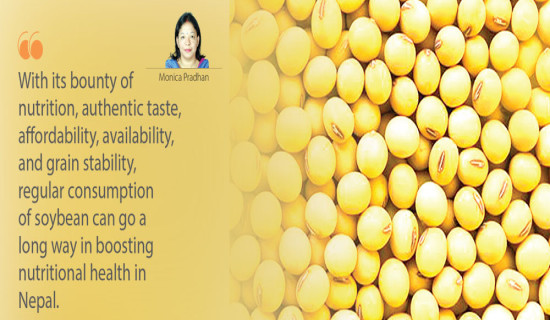- Saturday, 4 May 2024
Balancing Trade
Nepal's stubbornly high trade deficit continues to be a cause for concern. According to the statistics of the Department of Customs made public recently, Nepal has incurred a trade deficit of Rs. 1,053.42 billion in the first nine months of the current fiscal year 2023/24. Although the trade deficit decreased by 2.75 per cent compared to the same period last year, it is still large. The contribution of exports and imports to the total trade is 8.89 per cent and 91.11 per cent respectively. Owing to the declines in exports as well as imports, there was some improvement in the overall trade deficit. Foreign trade has decreased by 2.92 per cent compared to the same period last year.
The country's exports have declined by 3.66 per cent during the review period compared to the same period of last fiscal year 2022/23. Goods worth only Rs. 113.94 billion have been exported during the period, down from Rs. 118.27 billion over that period last fiscal. The dramatic reduction in the export of soybean oil and palm oil is said to have resulted in the decline in the overall export. Export of soybean oil has dropped by 90 per cent and palm oil by 67 per cent. During the first nine months, yarn worth above Rs. 8.6 billion, carpet worth Rs. 8.5 billion, tea and coffee worth Rs. 2.7 billion and cardamom worth Rs. 6.28 billion have been exported, while the export receipt for cement and clinkers stands at Rs. 2.97 billion.
At the same time, imports have decreased by 2.84 per cent, falling from Rs. 1,201.5 billion to Rs. 1,167.36 billion. The country has spent Rs. 37 billion for the import of cereals, including paddy and rice (Rs. 17.76 billion), wheat (Rs. 7.79 billion), maize (Rs. 10.88 billion) and millet (Rs. 603 million) during the period. While the import bill for import of electric vehicles stands at 17.5 billion, petroleum products stands at Rs. 211 billion.
The mammoth import bill for agriculture begs a question: Why is the country, where agriculture provides the livelihood to the vast majority of its people, imports so much agricultural produce? What is worrisome is that staples like rice, cereals, wheat, among others, account for the bulk of the import. Endowed with sizeable arable land, Nepal used to export rice, paddy, wheat and other produces until a few decades back, making agriculture one of the mainstays of our economy. But these days, many of our youths no longer find agriculture appealing enough to labour in the field. Many complain that crops yield doesn't even suffice to feed one's family. Because of this, arable land, mostly in the rural areas, lie fallow, underutilised.
There is one more critical issue demanding discussion: huge import bill for petroleum products. Hundreds of billions of rupees, primarily earned through remittance, is spent to fund this import. When so much money exits the country, we are left with scant resources to cover the expenditure in infrastructure building. This drain on foreign exchange resource stands in our path towards prosperity. The rise of electric vehicles (EVs) and electric cooking appliances, fueled by the increasing availability of hydroelectricity, has raised the hope that we'll will be consuming less and less imported fossil fuels. Besides, we also need to turn our attention to understand reasons behind our falling export. If needed, subsidy needs to be given to make our exports internationally competitive.

















